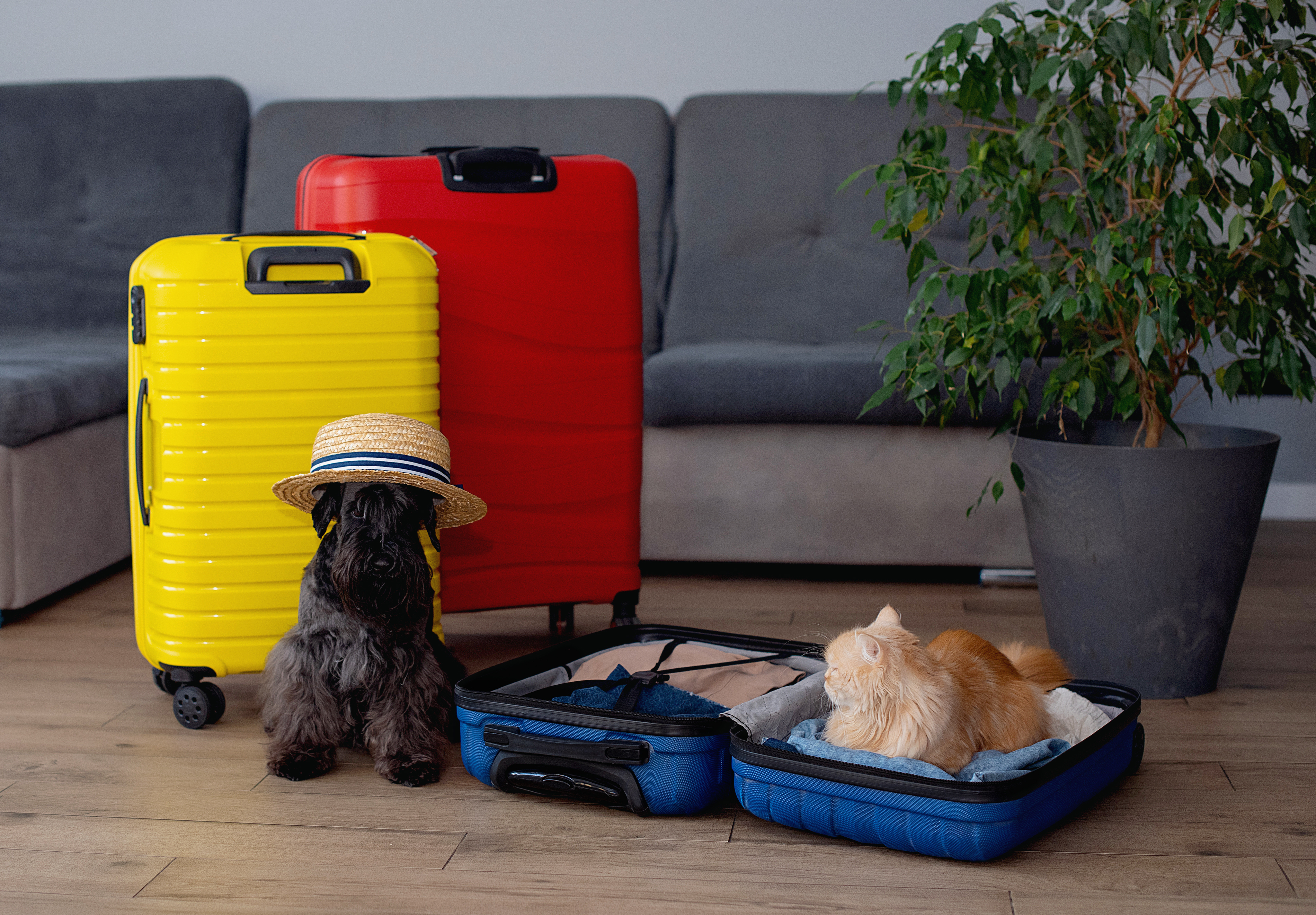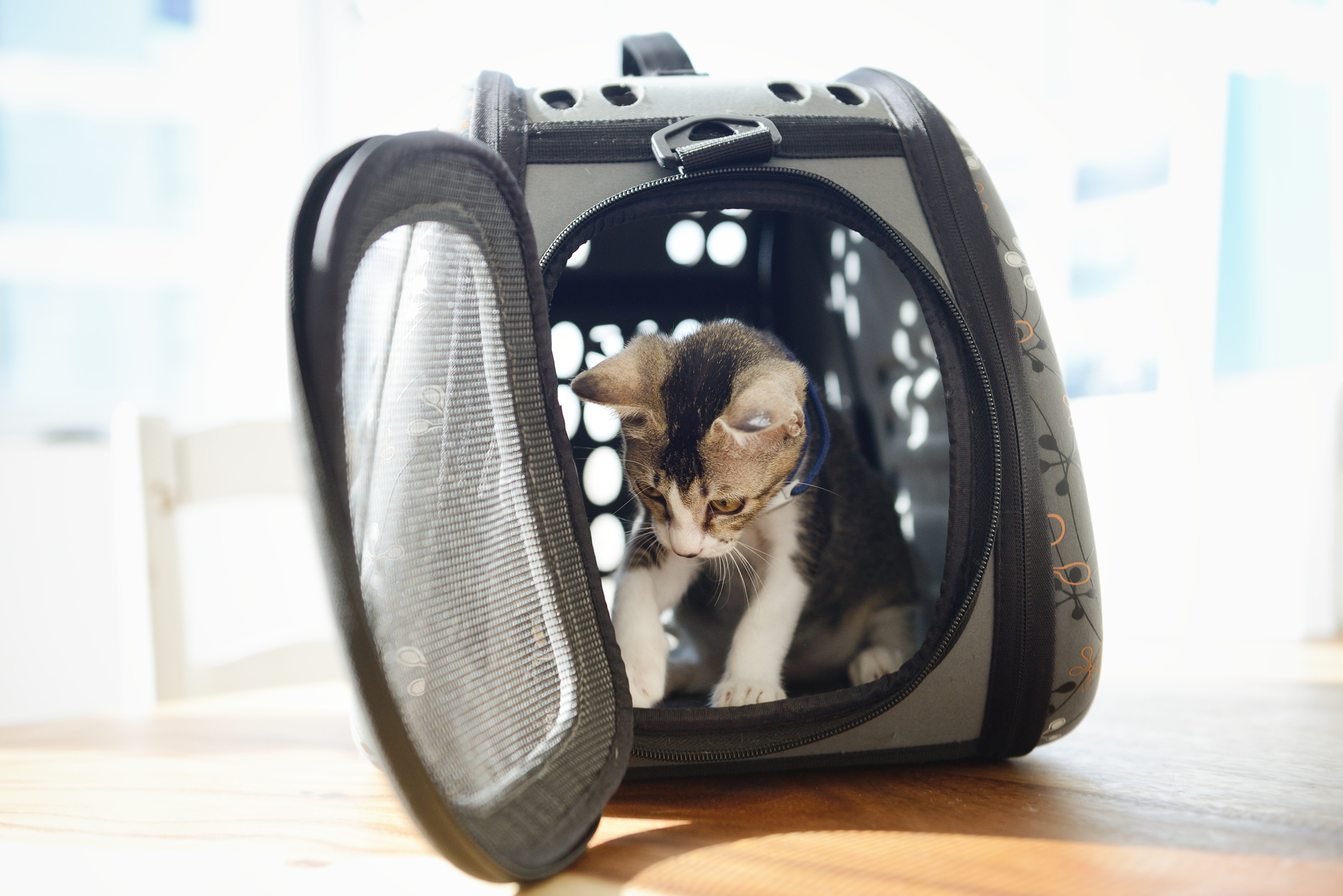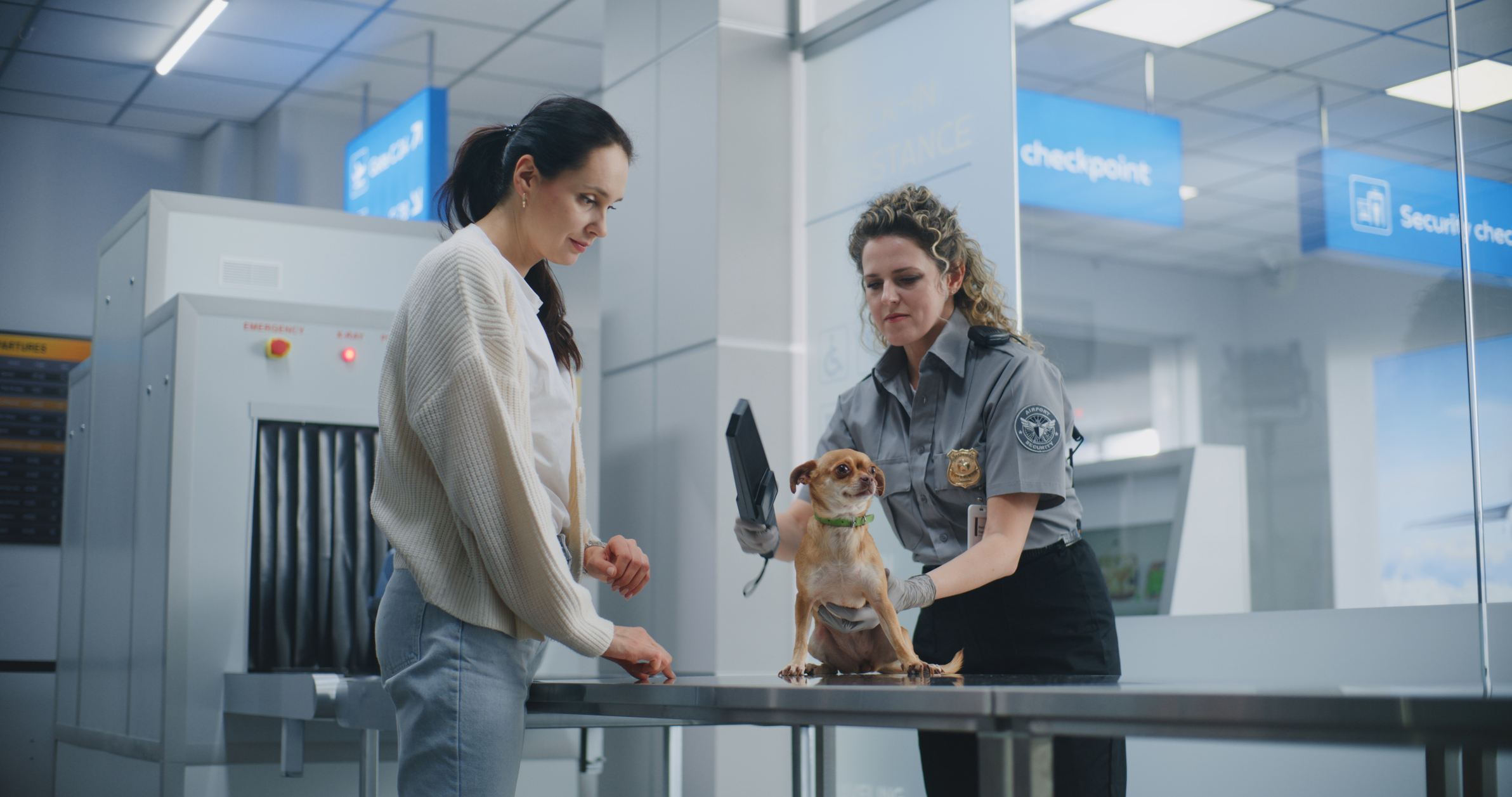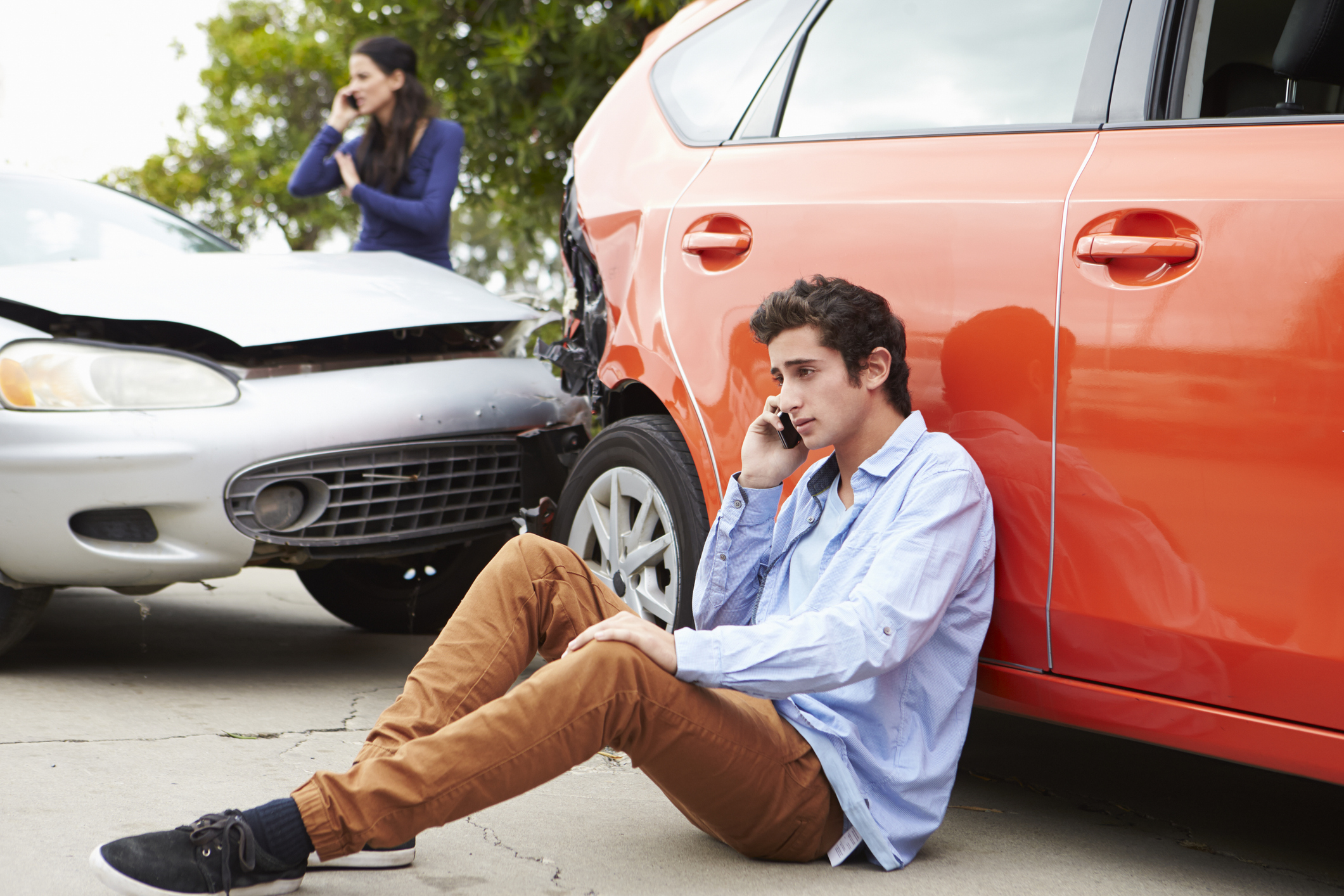How to Prevent an Emergency When Flying With Your Pet
More and more pet owners are including their pets in their travel plans. Here's how to do that safely and with as little stress as possible.


Two-thirds of dog owners and 80% of cat owners said they took their pets on a flight at least once in the previous year, according to a recent survey from the American Pet Products Association (APPA). Nearly a third said they'd taken their pets with them on three or more trips in that time.
The good news is that flying with your pet is relatively safe. Among all major airlines required to report animal losses, injuries or deaths to the Department of Transportation, there were just 13 incidents in 2024. With a total of 161,335 animals transported, that's a less than 0.01% chance of something going wrong when traveling with pets.
While the odds of something bad happening are low, when things do go wrong, they tend to go very wrong. Of those 13 reported incidents in 2024, 10 of them involved the death of an animal. So, it's worth doing whatever you can as a pet owner to keep your pet safe on their next flight. Here are the most important steps you can take, both before the flight and the day of, to protect your pet.
From just $107.88 $24.99 for Kiplinger Personal Finance
Become a smarter, better informed investor. Subscribe from just $107.88 $24.99, plus get up to 4 Special Issues

Sign up for Kiplinger’s Free Newsletters
Profit and prosper with the best of expert advice on investing, taxes, retirement, personal finance and more - straight to your e-mail.
Profit and prosper with the best of expert advice - straight to your e-mail.
What to do before the day of the flight
Make sure you pet is fit to fly
Flying can be stressful for any animal. But it's even more dangerous for pets that are very old, very young or who have preexisting health conditions. If you're unsure, call your vet to get their opinion on whether or not it's safe for your dog or cat to fly.
If the answer is no, consider taking a road trip with your pet instead. While the journey might be longer, you'll have much more control over the environment and stressors your pet is exposed to.
Check your destination's requirements for pets

Whether flying to a different state or a different country, you need to know the local regulations regarding importing animals. That might mean extra documentation from your vet, getting certain vaccines or even adhering to quarantine requirements once you land.
Whatever the requirements might be, you need to know these well in advance so you can prepare or adjust your travel plans accordingly.
Call the airline in advance
Since airline policies regarding pet travel can vary so widely, it's important to call the airline well in advance and before booking to get the specific policies you'll need to follow. Many airlines restrict the number of animals that can travel in the cabin, so the earlier you call (and book), the more likely you are to get the flight you want.
When you call, ask about any breed or size restrictions, additional carrier requirements and what documentation, if any, the airline requires. Most will require a health certificate from a vet confirming the pet is fit to fly.
The International Air Transport Association (IATA), an airline trade association, also recommends calling again 48 hours before departure to reconfirm these details. This just ensures that no mistakes or oversights were made and, if any were, they can be corrected before you show up at the airport.
Choose cabin over cargo if you can
Between flying in the cabin or in cargo, the cabin has a better track record. All 13 deaths and injuries reported last year involved pets traveling in the cargo hold. (That's not to say cargo is a death sentence, though. Again, out of more than 160,000 animals transported, just 13 suffered any incident at all.)
But if you have the option, keeping your furry friend with you in the cabin is the way to go. This can also make an already stressful ordeal that much less scary for your pet as their favorite human will be by their side the entire way.
For larger animals, this isn't possible as most airlines have size restrictions. If your pet has to be stowed in cargo, here are some tips from the IATA to minimize the stress and risks air travel poses:
- Book your flight on a weekday, as this is when airlines and airports are fully staffed, so the transport process will be smoother.
- Book your flight early in the day to minimize the risk of delays.
- Avoid air travel in the summer if you can to minimize the risk of heat-related illnesses in pets.
- Go for a walk or play with your pet to exercise them before leaving for the airport and, if possible, again before checking in.
- Remove collars, vests or harnesses before putting your pet in the carrier.
- Place an unwashed shirt of yours, a favorite blanket or another familiar item with your scent on it inside the carrier to help soothe your pet.
- Check in earlier than usual so the carrier can be put in a quiet area where your pet can relax before the flight.
Get an IATA-compliant carrier
When shopping for carriers or crates, you might see some that are labeled "airline approved" or "TSA approved." This is usually pretty meaningless marketing.
For one, the TSA has no pet carrier standards as it's not involved in transporting animals. For another, while airlines may have their own policies regarding animal transport, these would be unique to each airline, so there would be no universal "airline-approved" design.
Instead, it's the International Air Transport Association (IATA) that sets the safety standards for carriers used in air travel, both in the cabin and cargo hold.
You can find the detailed guidelines on the IATA website, but here's a quick summary of what a compliant in-cargo carrier looks like:
- Only rigid (hard-sided) carriers are allowed.
- The carrier must be big enough for the animal to stand up, sit or turn around while standing.
- The side walls must be solid, but with ventilation on at least 16% of the surface area on all four sides.
- The size of ventilation openings should be paw and nose-proof.
- There should be spacer bars on the back and sides of the container to prevent other baggage or cargo from blocking the ventilation openings.
- Absorbent bedding should be placed in the carrier.
- Open food and water containers should be attached to the crate and able to be refilled from the outside without opening the crate.
- The animal's name should be written on the outside of the carrier.
- There are additional guidelines depending on the type and construction of the carrier.
For in-cabin carriers, the guidelines are similar except that the carrier doesn't have to be rigid and doesn't need spacer bars. It also doesn't need attached food and water containers.
Acclimate your pet to the new carrier
If possible, get that IATA-compliant carrier months ahead of your flight. Keep it out and open with a favorite blanket or bed inside so your dog or cat can get used to it.
Come departure day, everything else about your pet's surroundings will be unfamiliar and overstimulating. So, you want this carrier to feel like a safe, familiar space.
Get pet insurance
Emergency vet visits during your trip can easily wipe out your travel budget (and even your emergency fund). If you don't already have it, it's a good idea to get pet insurance before you fly to minimize that risk.
Make sure to get your coverage lined up early, though. Many policies have a waiting period before they kick in. This can be anywhere from one day to one month, depending on the provider. Check the waiting period before signing up to make sure the policy you're getting will be fully active before the day of your flight.
Lemonade pet insurance is one of the top-rated brands among pet owners. Get a customized pet insurance quote today to see how much it would cost to cover your furry friend..
What to do on the day of your flight
Don't sedate your pet unless your vet recommends it
While a sedative or anti-anxiety medication might seem like a surefire way to keep your pet calm and relaxed during the flight, the IATA actually advises against it. Most sedatives come with side effects that can impact your pet's ability to manage the stresses of flying.
For example, tranquilizers can lower blood pressure. But high altitudes also lower blood pressure. When these two effects are combined, it can be fatal.
If your vet thinks the benefits of sedatives outweigh these risks, make sure to keep a record of the drug name, dosage and exact time of administration on hand. If emergency vet care is needed at any stage of the journey, you want this information on hand to help diagnose issues and decide the best treatment.
Food and water
According to the IATA, you want to keep your pet fed, but not overly full. The agency recommends feeding smaller amounts the day before in preparation.
On the day of, feed your pet a light meal two hours before departure time. Then, right before you load your pet in the carrier, provide them with some water.
For travel times under 12 hours, additional feeding usually isn't required, according to the IATA. But keeping food handy in case of delays is a good idea. If feeding during travel time, keep meals smaller than usual.
Exercise
Tiring your pet out can help keep them calm and relaxed while traveling. Take your pet on a long walk or engage in a vigorous play session shortly before leaving for the airport.
Then, if it's safe to do so at the airport, take them out of their carrier again for another walk or play session right before checking in (if they're flying cargo) or boarding (if they're flying in the cabin). Some airports have areas for you to do this.
When to check in

The IATA recommendation is to check in as early as possible for animals flying in cargo or as late as possible for animals flying in the cabin with you. In the latter case, you're trying to minimize the time spent in the unfamiliar and overstimulating environment.
But you don't want to risk missing your flight. So, do some planning in advance to figure out the ideal check in time that ensures you'll get to your gate on time but minimizes the amount of time your pet spends at the airport.
Get through TSA
When going through security, TSA will need you to remove your pet from the carrier so that the carrier can go through the X-ray machine. Make sure your pet has their harness on and be ready to leash them so they can't bolt after they're removed from the carrier.
If you're flying with a cat who isn't already harness-trained, it's a good idea to get them used to wearing one a few months ahead of traveling.
The TSA recommends carrying your pet throughout the screening process rather than letting them walk. After getting through the screening, the agency also recommends taking the carrier and your pet away from the crowded security area and loading them back into the carrier in a quieter area.
Compare pet insurance quotes at The Zebra
The Zebra is an insurance marketplace that checks over 100 insurers to give you multiple personalized quotes on pet insurance so you can easily compare rates side by side.
Talk to the flight crew before takeoff
Ask the crew while boarding what their procedures are for handling pets in an emergency. Since pets usually aren't mentioned in the normal safety announcement and are kind of an afterthought when it comes to flight emergencies, this is a good time to get on the same page.
Specifically, you want to ask about what to do in the event of turbulence or an evacuation. You also want to ask for a spare oxygen mask if available. Airplanes are equipped with extra masks, normally intended for babies sitting on your lap. But the crew may be able to give you one to use for your pet.
Since these are designed for human faces, it may take some trial and error to get it on and you may end up just needing to hold it against their face. Just make sure it's not pressed against their nose, which could end up blocking their ability to inhale. Because of this, you should definitely make sure to follow the "put your own mask on first" rule you hear in every flight safety announcement.
Keep your pet in the carrier
The safest place for your pet during the flight is inside their carrier. You can place it on your lap or the seat beside you (provided it's empty), but you generally want to keep them contained.
If there's any turbulence, they need to be inside their carrier under the seat so they aren't thrown around the cabin. This will be easier to do if they're already in their carrier.
For the same reason, keep toys or food bowls stored outside of the carrier when not in use. During turbulence, these loose items might get thrown around and hurt your pet.
Know what to do in an evacuation
In the event of an evacuation, you usually can't bring any luggage with you, pet carriers included. So, you'll probably need to remove them from the carrier and hold them in your arms as you deplane.
If your pet is prone to becoming spooked, it might be safer to keep them in their carrier rather than risk them bolting inside the aircraft. But, this might be in defiance of the airline policy. As the pet owner, you'll need to decide the safest course of action for your pet.
Get more insurance tips and other personal finance insights straight to your inbox. Subscribe to our daily newsletter, A Step Ahead.
Related content
Profit and prosper with the best of Kiplinger's advice on investing, taxes, retirement, personal finance and much more. Delivered daily. Enter your email in the box and click Sign Me Up.

Rachael Green is a personal finance eCommerce writer specializing in insurance, travel, and credit cards. Before joining Kiplinger in 2025, she wrote blogs and whitepapers for financial advisors and reported on everything from the latest business news and investing trends to the best shopping deals. Her bylines have appeared in Benzinga, CBS News, Travel + Leisure, Bustle, and numerous other publications. A former digital nomad, Rachael lived in Lund, Vienna, and New York before settling down in Atlanta. She’s eager to share her tips for finding the best travel deals and navigating the logistics of managing money while living abroad. When she’s not researching the latest insurance trends or sharing the best credit card reward hacks, Rachael can be found traveling or working in her garden.
-
 Stocks Chop as the Unemployment Rate Jumps: Stock Market Today
Stocks Chop as the Unemployment Rate Jumps: Stock Market TodayNovember job growth was stronger than expected, but sharp losses in October and a rising unemployment rate are worrying market participants.
-
 Should You Renew Your CD?
Should You Renew Your CD?With rate cuts impacting earnings, we examine if now is a wise time to renew CDs.
-
 7 Ways to Plan Now to Save on Medicare IRMAA Surcharges Later
7 Ways to Plan Now to Save on Medicare IRMAA Surcharges LaterUnderstand the critical two-year lookback period and why aggressive planning before you enroll in Medicare is the most effective way to minimize IRMAA.
-
 Should You Renew Your CD?
Should You Renew Your CD?With rate cuts impacting earnings, we examine if now is a wise time to renew CDs.
-
 Where to Store Your Cash in 2026
Where to Store Your Cash in 2026Set yourself up for success with these strategies.
-
 I'm a Financial Adviser: The Fed's Rate Cuts Could Have Impacts You Might Not Anticipate
I'm a Financial Adviser: The Fed's Rate Cuts Could Have Impacts You Might Not AnticipateUnderstanding how lower interest rates could impact your wallet can help you determine the right financial moves to make.
-
 My Teen Crashed His Car, and Now Our Insurance Has Tripled. What Now?
My Teen Crashed His Car, and Now Our Insurance Has Tripled. What Now?Dealing with the costly aftermath of a teen car accident is stressful. Here are your options for navigating it.
-
 My First $1 Million: Retired In-House Corporate Lawyer, 74, Midwest
My First $1 Million: Retired In-House Corporate Lawyer, 74, MidwestEver wonder how someone who's made a million dollars or more did it? Kiplinger's My First $1 Million series uncovers the answers.
-
 I'm an Insurance Pro: Going Without Life Insurance Is Like Driving Without a Seat Belt Because You Don't Plan to Crash
I'm an Insurance Pro: Going Without Life Insurance Is Like Driving Without a Seat Belt Because You Don't Plan to CrashLife insurance is that boring-but-crucial thing you really need to get now so that your family doesn't have to launch a GoFundMe when you're gone.
-
 The Top 22 Gifts for Grandkids from Walmart in 2025
The Top 22 Gifts for Grandkids from Walmart in 2025From PlayStation to Labubu, you'll find the hottest gifts of 2025 for your grandkids at Walmart this year. Some of them are up to 78% off.
-
 What Not to Do in an Airport Lounge
What Not to Do in an Airport LoungeBefore you settle into that cushy lounge chair, skip the rookie moves that annoy other travelers and can even get you kicked out.

